The Gipfeli recipe is one of those beloved pastries that holds a special place in Swiss culture, and I can’t wait to share it with you. While it’s often compared to the French croissant, the Gipfeli recipe has its own unique charm. It’s a bit less buttery, slightly denser, and has a wonderfully crisp exterior. Growing up, I remember enjoying a fresh Gipfeli with a warm cup of coffee, especially on cozy mornings or special occasions. In Switzerland, Gipfeli is a breakfast staple you’ll find in almost every bakery. What I love most about the Gipfeli recipe is how it brings a touch of tradition to your table, yet it’s simple enough to make at home.
In this guide, I’ll walk you through everything you need to know about the Gipfeli recipe—from its cultural significance to how it differs from croissants, and of course, how to make these flaky, delicious pastries from scratch. It’s one of those recipes that’s both comforting and rewarding to bake, and I’m sure you’ll enjoy it as much as I do!
Summary
What is Gipfeli?
The Swiss Take on a Classic Pastry
The Gipfeli recipe is Switzerland’s take on the crescent-shaped, flaky breakfast pastry found in many European bakeries. While it may look similar to a croissant, the Gipfeli recipe has a firmer texture, contains less butter, and is slightly crispier, giving it a distinct and delightful flavor.
How Gipfeli Differs from Croissants
Although Gipfeli and croissants share a common heritage, they differ in key ways:
| Feature | Gipfeli | Croissant |
|---|---|---|
| Butter Content | Less butter, firmer texture | High butter content, flaky layers |
| Crispiness | Slightly crispy exterior | Soft and ultra-flaky layers |
| Dough Type | Less laminated, denser | More laminated, airy texture |
| Taste | Mildly sweet, subtle richness | Buttery, richer in flavor |
Unlike croissants, which have multiple thin, buttery layers, Gipfeli recipe dough is simpler and results in a more structured pastry.
Ingredients Needed for Gipfeli Recipe
Basic Ingredients for the Dough
Making authentic Swiss Gipfeli Recipe requires simple ingredients, most of which are likely already in your kitchen. The key to a perfect Gipfeli lies in the balance between flour, yeast, and butter, creating a pastry that is both light and slightly crispy.
Essential Ingredients:
- 500g (4 cups) all-purpose flour – Provides structure to the dough.
- 1 packet (7g) instant yeast – Helps the dough rise and develop a soft texture.
- 50g (¼ cup) sugar – Adds a mild sweetness.
- 1 teaspoon salt – Enhances flavor and controls yeast activity.
- 250ml (1 cup) warm milk – Activates the yeast and adds moisture.
- 50g (3.5 tbsp) unsalted butter, softened – Creates a tender dough.
- 1 egg – Adds richness and structure.
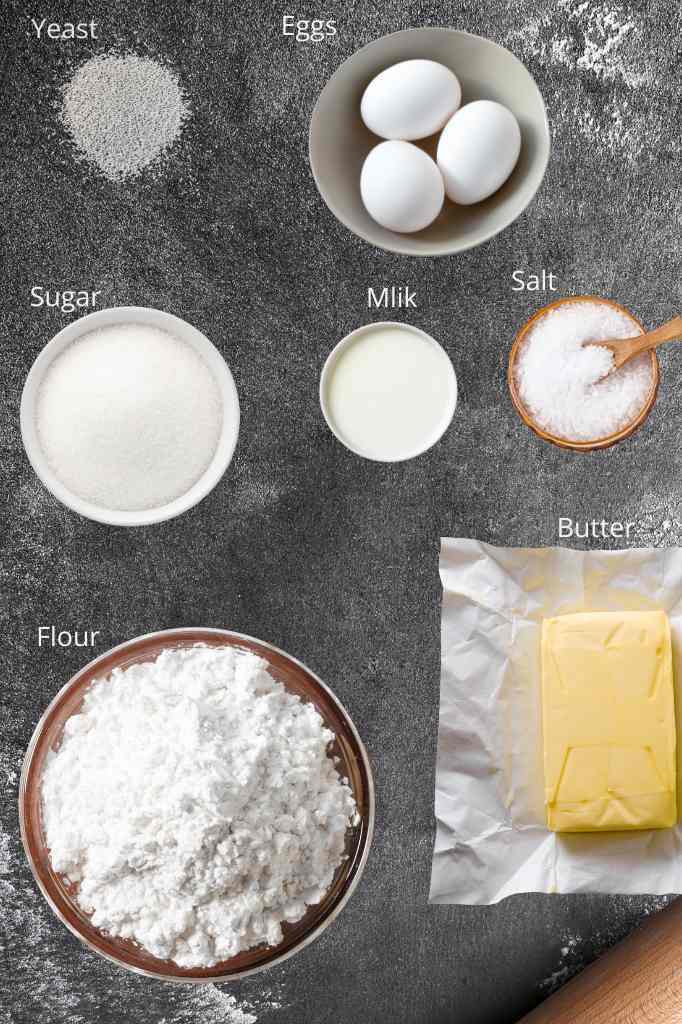
The Role of Butter in Gipfeli Recipe vs. Croissants
One of the biggest differences between Gipfeli recipe and croissants is the amount of butter used. Traditional croissants require a high butter content and extensive lamination (layering of butter and dough), resulting in their signature flaky texture.
Gipfeli recipe, on the other hand, contains less butter, making it slightly denser and crispier on the outside. The dough is still folded and layered but in a simpler way, leading to a more structured bite.
| Feature | Gipfeli | Croissant |
|---|---|---|
| Butter Amount | Moderate, mixed into dough | High, layered between folds |
| Texture | Firm but slightly crispy | Soft, airy, and flaky |
| Lamination | Less layering, simpler process | Multiple thin layers, more work |
Preparing the Dough for Gipfeli recipe
The moment the flour hits the bowl, the promise of warm, flaky Gipfeli begins to take shape. Picture yourself standing in your kitchen, the scent of freshly activated yeast mingling with the sweetness of warm milk and butter as you begin the dough-making process. The texture of the dough will play a key role in the final result, so it’s essential to take your time here, allowing each step of the Gipfeli recipe to unfold with care.
Step 1: Mixing the Ingredients
To achieve a soft and elastic dough for your Gipfeli recipe, follow these steps carefully:
Activate the yeast:
- If using instant yeast, you can mix it directly with the flour.
- If using active dry yeast, dissolve it in lukewarm milk with a teaspoon of sugar. Let it sit for about 5-10 minutes until it becomes frothy.
- Combine the dry ingredients:
- In a large mixing bowl, combine the flour, sugar, and salt by whisking them together.
- Make a small well in the center.
- Add the wet ingredients:
- Pour in the warm milk and yeast mixture (if using active yeast).
- Add the softened butter and one beaten egg.
- Mix until a dough forms:
- Use a wooden spoon or a stand mixer with a dough hook attachment to combine the ingredients.
- The dough should start coming together into a sticky mass.
Step 2: Kneading the Dough
This is the moment where the dough for your Gipfeli recipe starts to feel alive beneath your fingertips.
How to Knead the Dough by Hand:
- Dust a clean surface with a little flour and transfer the dough onto it.
- Using the heel of your hand, push the dough away, then fold it back toward you.
- Rotate the dough slightly and repeat the motion.
- Continue kneading for about 8-10 minutes until the dough is:
- Smooth and elastic
- No longer sticky
- Able to stretch without tearing
Tip: If the dough is too sticky, sprinkle a little flour—but don’t overdo it, or the Gipfeli will be too dense.
Using a Stand Mixer:
- Attach the dough hook.
- Knead on medium speed for about 5-6 minutes until the dough pulls away from the sides.
Step 3: First Dough Rising
Now comes the most rewarding part of the Gipfeli recipe—the rising.
- Lightly grease a large bowl with butter or oil.
- Place the dough inside and cover it with a clean kitchen towel or plastic wrap.
- Let it rise in a warm place for 1 to 1.5 hours, or until it doubles in size.
The air will have a hint of sweetness as the dough for your Gipfeli recipe rests, and the aroma of yeast will begin to fill the room, giving you a sneak peek of the magic to come. This is the start of something wonderful—soft, golden, flaky Gipfeli that will fill your kitchen with warmth and comfort.
Best Rising Conditions:
| Temperature | Estimated Rising Time |
|---|---|
| Warm room (21-24°C / 70-75°F) | 1.5 hours |
| Slightly cool room (18-20°C / 64-68°F) | 2 hours |
Tip: If your kitchen is cold, you can place the dough in a slightly warmed (but turned off) oven or near a sunny window.
Laminating the Dough for Perfect Layers
Laminating the dough is the secret to that irresistible, flaky texture that makes Gipfeli recipe so special. As you fold and roll the dough, you’ll feel it transform—becoming light and airy, with layers of buttery goodness nestled within.
Though Gipfeli recipe uses less butter than a croissant, this process is still key to achieving that perfect balance between a crisp, golden exterior and a tender, melt-in-your-mouth interior. The sight of the dough folding and the smell of warm butter wafting through the kitchen will already have you dreaming of the delicate, crisp layers waiting to be savored.
Step 4: Rolling Out the Dough
- Lightly flour your work surface.
- Turn out the risen dough and gently punch it down to release air.
- Roll the dough into a large rectangle, approximately 40×25 cm (16×10 inches).
- Keep the thickness around 5mm (¼ inch).
- Try to maintain an even shape for easier folding.
Step 5: Adding Butter Layers
Instead of the traditional croissant butter block, Gipfeli recipe requires a simpler layering process.
Preparing the Butter:
- 100g (7 tbsp) unsalted butter, cold
- Cut the butter into thin slices or grate it using a cheese grater for even distribution.
Incorporating the Butter:
- Spread the butter slices over two-thirds of the dough.
- Fold the unbuttered third of the dough over the middle section.
- Fold the remaining third over the top (like folding a letter).
This process in the Gipfeli recipe creates three layers of dough and two layers of butter.
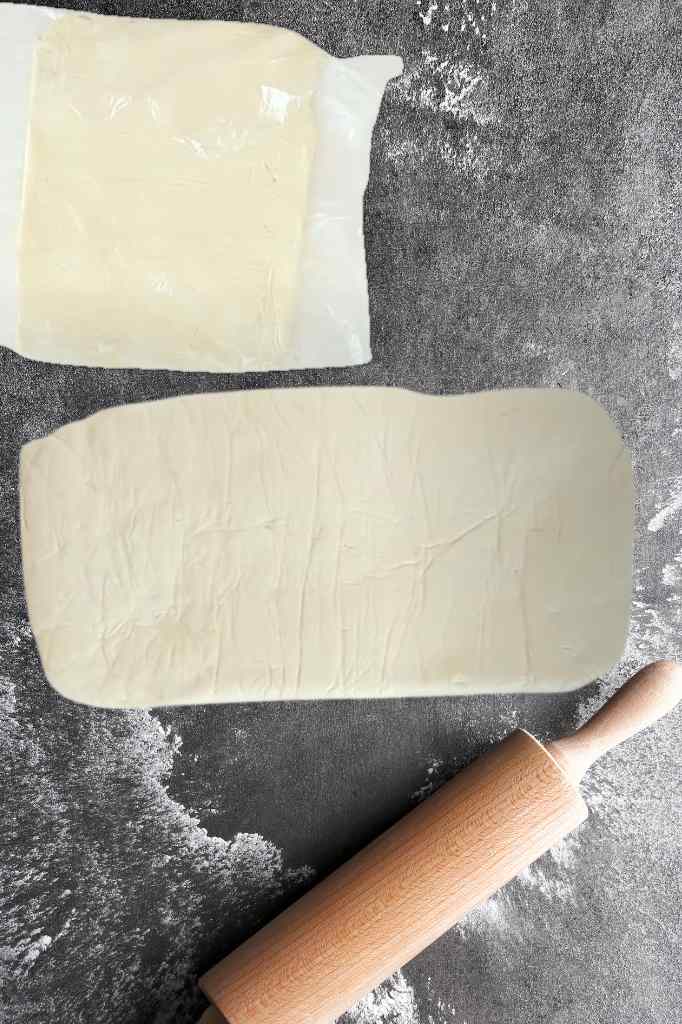
Step 6: Folding and Chilling the Dough
- Rotate the dough 90 degrees so the short side is facing you.
- Roll it out again into a rectangle (40×25 cm).
- Repeat the letter fold process.
- Cover the dough with plastic wrap and chill it in the refrigerator for at least 30 minutes to let the butter set.
Why is Chilling Important?
Refrigerating the dough prevents the butter from melting into the dough, keeping the layers separate. This step ensures a flaky texture when baked.
| Step | Purpose | Time Required |
|---|---|---|
| Rolling Out | Creates an even dough base | 5 minutes |
| Folding | Traps butter between layers | 5 minutes |
| Chilling | Firms butter for crispiness | 30 minutes |
Shaping the Gipfeli
Now that the dough for your Gipfeli recipe has been laminated and chilled, it’s time to shape the Gipfeli into their signature crescent form. This step is crucial for achieving the right texture and appearance.
Step 7: Cutting the Dough into Triangles
- Lightly flour your work surface and roll out the chilled dough into a large rectangle, about 40×25 cm (16×10 inches) and 5mm (¼ inch) thick.
- Using a sharp knife or a pizza cutter, divide the dough into triangles with a base of about 8-10 cm (3-4 inches) and a height of 15 cm (6 inches).
Tip: For even shapes in your Gipfeli recipe, first mark the dough before cutting. You should get 8-10 triangles from this batch.
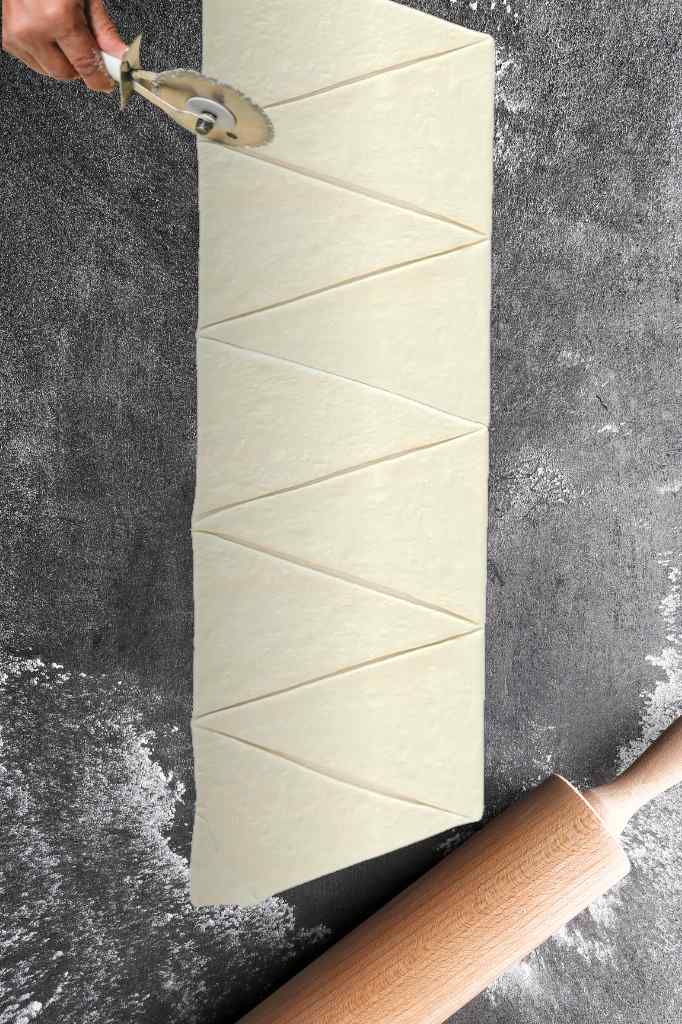
Step 8: Rolling the Dough into Crescent Shapes
- Gently stretch each triangle, especially at the base, to elongate it slightly.
- Starting at the wide end, roll the dough toward the tip, applying light pressure.
- Make sure the tip is tucked underneath to prevent unrolling during baking.
- Slightly curve the edges to form the classic crescent shape.
Optional: If you are making Nussgipfel (nut-filled Gipfeli) or Schoggigipfel (chocolate-filled Gipfeli), now is the time to:
- Place 1-2 teaspoons of the filling at the base of each triangle before rolling.
- Seal the edges lightly to prevent leaking during baking.
Final Resting Time for Gipfeli Recipe
Before baking, the shaped Gipfeli need a second rise:
- Arrange the shaped Gipfeli on a baking tray lined with parchment paper.
- Cover them loosely with a kitchen towel.
- Let them rest in a warm place for 30-45 minutes, or until they puff up slightly.
This final proofing ensures the Gipfeli are light and airy once baked.
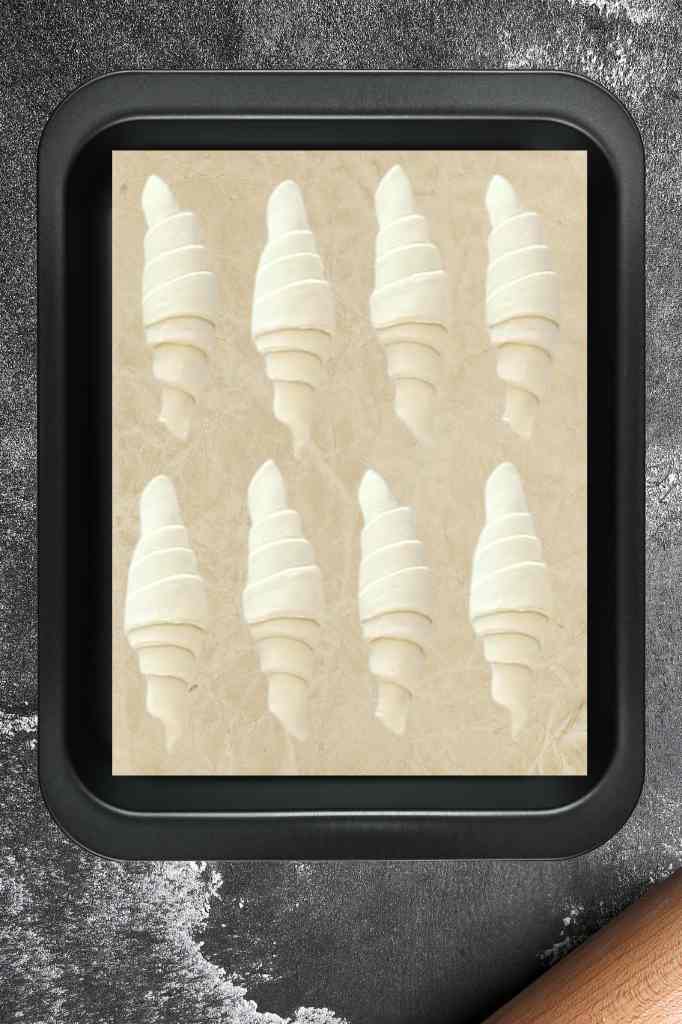
Baking the Perfect Gipfeli
Now that the Gipfeli are shaped and have risen to perfection, it’s time to bake them into golden, crispy treasures. As the dough hits the hot oven, the aroma of baking pastry fills the air—warm, comforting, and slightly sweet. With each passing minute, the outside begins to turn a deep golden brown, becoming beautifully crisp, while the inside remains soft and airy, almost buttery to the touch.
The contrast between the crunchy exterior and the tender layers inside is exactly what makes each bite of this Gipfeli recipe so irresistible. It’s a moment of transformation, where the dough you’ve lovingly shaped becomes the perfect pastry—flaky, light, and utterly delicious.
Step 9: Applying the Egg Wash
To give Gipfeli recipe their signature golden color and slight sheen, we apply an egg wash before baking.
Egg Wash Ingredients:
- 1 egg yolk
- 1 tablespoon milk
How to Apply Egg Wash:
- In a small bowl, beat the egg yolk and milk together until well combined.
- Using a pastry brush, lightly coat each Gipfeli with the egg wash.
- Be gentle to avoid deflating the dough.
- Brush only the surface—don’t let excess egg wash drip underneath.
Step 10: Baking Time and Temperature
Baking Instructions:
- Preheat your oven to 190°C (375°F).
- A well-heated oven ensures even baking and a crispy crust.
- Place the baking sheet on the middle rack of the oven.
- Bake for 18-22 minutes, or until the Gipfeli are:
- Golden brown on top
- Crispy on the outside but still soft inside
Tip: If your oven has uneven heating, rotate the baking sheet halfway through baking your Gipfeli recipe for even browning.
| Oven Temperature | Baking Time | Result |
|---|---|---|
| 180°C (350°F) | 20-22 min | Softer, less crispy Gipfeli |
| 190°C (375°F) | 18-20 min | Perfect balance of crispy & soft |
| 200°C (400°F) | 15-18 min | Extra crispy, faster baking |
Cooling and Serving
- Remove the Gipfeli from the oven and transfer them to a wire rack to cool slightly.
- Let them rest for 5-10 minutes before serving to allow the structure to set.
- Enjoy warm with butter, jam, honey, or even Swiss chocolate spread!
Serving and Enjoying Swiss Gipfeli
Pairing Gipfeli with Swiss Breakfast Beverages
The Gipfeli recipe is a staple of Swiss breakfasts, often enjoyed with a warm beverage. Here are some classic pairings:
| Beverage | Why It Pairs Well with Gipfeli |
|---|---|
| Swiss Coffee (Café Crème) | The mild bitterness of coffee balances the subtle sweetness of Gipfeli. |
| Hot Chocolate (Schoggi Milch) | A rich and creamy option, especially loved by children. |
| Tea | Herbal or black tea complements the light texture of Gipfeli. |
| Ovomaltine (Ovaltine) | A popular Swiss malted drink that pairs perfectly with pastries. |
For a more indulgent experience, try dipping Gipfeli in coffee or hot chocolate!
Best Ways to Serve Gipfeli
While Gipfeli Recipe is delicious on its own, you can enhance the experience with different accompaniments:
Sweet Additions:
- Butter and Swiss Honey – A classic Swiss breakfast combination.
- Homemade Jam (Apricot or Raspberry) – Adds fruity sweetness.
- Nutella or Swiss Chocolate Spread – Perfect for chocolate lovers.
Savory Options:
- Cheese – A great choice for a more filling breakfast.
- Herb Butter or Cream Cheese – Adds a creamy, flavorful touch.
Storage Tips for Freshness
Since the homemade Gipfeli recipe doesn’t contain preservatives, it’s best enjoyed fresh. However, here’s how you can keep them tasting great:
Short-Term Storage (1-2 Days):
- Keep the Gipfeli in an airtight container at room temperature.
- Avoid refrigerating, as it can dry them out.
- Reheat in a preheated oven at 160°C (320°F) for 5 minutes to restore crispiness.
Freezing Gipfeli (Up to 3 Months):
- Before Baking: After shaping the Gipfeli, freeze them on a tray, then transfer to a freezer bag. When ready to bake, let them thaw and rise for 2 hours before baking.
- After Baking: Allow the baked Gipfeli to cool completely, then store in a freezer bag. Reheat in a 180°C (350°F) oven for 8-10 minutes before serving.
Swiss Variations of Gipfeli Recipe
While the classic butter Gipfeli recipe is a beloved staple in Switzerland, there are several delicious variations that add exciting flavors and textures. From nut-filled Nussgipfel to chocolate-filled Schoggigipfel, these regional adaptations showcase the versatility of this pastry.
Nussgipfel: The Nut-Filled Version
What is Nussgipfel?
Nussgipfel, or “nut Gipfeli,” is a delicious twist on the classic pastry, featuring crisp, golden layers filled with a rich, slightly sweet mixture of hazelnuts or almonds. The earthy aroma of the nuts blends perfectly with the buttery dough, creating a comforting and flavorful treat. A favorite in Swiss bakeries, Nussgipfel offers a perfect balance of flaky texture and nutty depth, making each bite irresistible.
Ingredients for Nussgipfel Filling:
- 150g (1 ½ cups) ground hazelnuts or almonds
- 50g (¼ cup) sugar
- 1 tbsp honey
- 1 tbsp milk
- ½ tsp cinnamon
- 1 egg white (to help bind the mixture)
How to Add the Filling:
- Prepare the filling: Mix all ingredients in a bowl until it forms a thick paste.
- Place the filling: Before rolling the dough, add 1-2 teaspoons of the nut mixture at the base of each triangle.
- Seal the edges lightly to prevent leaking during baking.
- Proceed with rolling and baking as usual.
Schoggigipfel: The Chocolate-Filled Version
What is Schoggigipfel?
Schoggigipfel, or chocolate Gipfeli, is a rich and indulgent pastry with a crispy, golden exterior and a warm, melting chocolate filling. Unlike the buttery softness of a traditional pain au chocolat, it maintains the signature crunch of Gipfeli, offering a satisfying bite. The sweet aroma of chocolate and the nutty fragrance of the dough make it an irresistible treat, perfect for pairing with coffee or enjoying as a snack. It’s the ideal balance of rich chocolate and flaky pastry.
How to Add Chocolate to Gipfeli:
- Use small pieces of Swiss chocolate (milk or dark).
- Place a chocolate stick or 1-2 squares of chocolate at the base of each dough triangle.
- Roll up the dough as usual, ensuring the chocolate is fully covered.
- Bake and enjoy melted chocolate inside a flaky Gipfeli!
Other Regional Swiss Pastries Similar to Gipfeli
Bürli
A rustic Swiss bread roll with a crunchy crust and soft interior. Often eaten as an alternative to Gipfeli for breakfast.
Zopf
A buttery braided bread that is sweeter and denser than Gipfeli. It’s a Sunday morning tradition in many Swiss households.
Weggli
A soft, slightly sweet Swiss milk bun often enjoyed by children with a piece of chocolate or butter.
Frequently Asked Questions about Gipfeli recipe
To help you understand more about Gipfeli and Swiss pastries, here are answers to some of the most commonly asked questions.
What are the ingredients in Nussgipfel?
Nussgipfel (nut-filled Gipfeli) contains a sweet nut filling, usually made from:
- Ground hazelnuts or almonds
- Sugar
- Honey
- Milk
- Cinnamon
- Egg white (for binding)
These ingredients are mixed into a thick paste and added inside the dough before rolling.
What ingredients are in a croissant?
A traditional French croissant includes:
- Flour
- Yeast
- Milk
- Sugar
- Butter (lots of it!)
- Salt
Unlike Gipfeli, croissant dough is laminated with multiple butter layers to create its famous flaky texture.
What is the Swiss version of a croissant?
The Swiss equivalent of a croissant is the Gipfeli recipe. It is similar in shape but has a firmer, crispier texture with less butter.
Other Swiss breakfast pastries include:
- Nussgipfel (nut-filled variation)
- Schoggigipfel (chocolate-filled version)
- Butterzopf (braided Swiss bread, often eaten with butter and jam)
What is the most popular bread in Switzerland?
Switzerland has a rich bread culture, but some of the most popular breads include:
- Zopf – A soft, slightly sweet braided bread, commonly eaten on Sundays.
- Ruchbrot – A whole grain, rustic bread with a hearty texture.
- Bürli – Small, crusty bread rolls often served with Swiss cheese or meats.
- Weggli – A soft milk bread roll, popular with children.
- Gipfeli – The Swiss take on the croissant, enjoyed at breakfast.
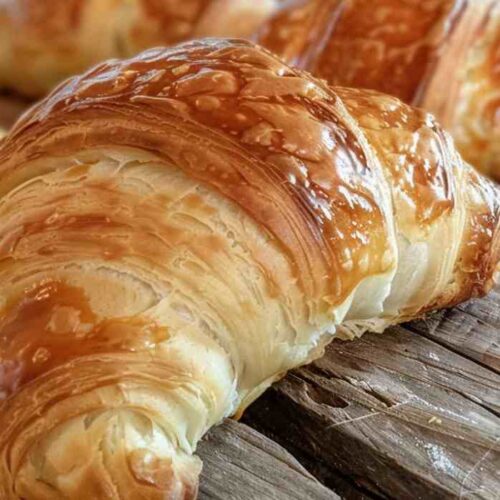
Authentic Swiss Gipfeli Recipe
Ingredients
For the Dough:
- 4 cups all-purpose flour (500g)
- 1 packet instant yeast (7g)
- ¼ cup sugar (50g)
- 1 tsp salt
- 1 cup warm milk (250ml)
- 3.5 tbsp unsalted butter, softened (50g)
- 1 egg
For Laminating the Dough:
- 7 tbsp unsalted butter, cold and sliced thin 100g
For Egg Wash:
- 1 egg yolk
- 1 tbsp milk
Instructions
Step1: Prepare the Dough
- In a bowl, mix flour, sugar, and salt.
- Dissolve yeast in warm milk and let it sit for 5 minutes.
- Add the yeast mixture, softened butter, and egg to the dry ingredients.
- Knead until the dough is smooth and elastic (8-10 min).
- Cover and let it rise for 1-1.5 hours or until doubled in size.
Step2: Rolling and Laminating the Dough
- Roll out the dough into a 40×25 cm (16×10 inch) rectangle.
- Spread the cold butter slices over two-thirds of the dough.
- Fold like a letter (unbuttered section over buttered section).
- Roll out again and repeat folding for a flakier texture.
- Cover and chill for 30 minutes in the fridge.
Step 3: Shaping the Gipfeli
- Roll the chilled dough into a large rectangle (5mm thick).
- Cut into triangles (10 cm base, 15 cm height).
- Roll each triangle from base to tip, tucking the tip under.
- Place on a lined baking sheet and let rise 30-45 minutes.
Step 4: Baking
- Preheat oven to 190°C (375°F).
- Brush with egg wash for a golden crust.
- Bake for 18-22 minutes or until golden brown.
- Let cool on a wire rack and enjoy!
Notes
📌 Tips & Variations
✔ For Nussgipfel (Nut-Filled): Add 1-2 tsp of a hazelnut filling before rolling. ✔ For Schoggigipfel (Chocolate-Filled): Place a piece of chocolate inside before rolling. ✔ Make-Ahead Option: Freeze shaped, unbaked Gipfeli, then thaw and bake fresh.Related Recipes
4 Ingredient Banana Bread Recipe – The Easiest & Best!






1 thought on “Authentic Swiss Gipfeli Recipe – How to Make This Flaky Pastry”